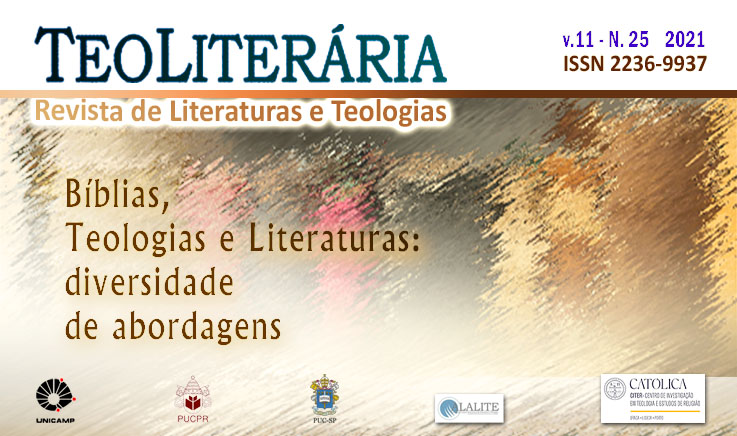A Bíblia do Conto da AIA
DOI:
https://doi.org/10.23925/2236-9937.2021v25p52-71Palabras clave:
Bíblia, Conto da Aia, Releituras, InterpretaçãoResumen
Teóricos e pesquisadores tem argumentado com cada vez mais fundamento que também na literatura “nada se cria, nada se perde, tudo se transforma”. Este princípio de Lavoisier também se aplica à literatura. Os estudos de recepção de texto estão a evidenciar as relações de intertextualidade que os discursos podem assumir. A Bíblia, como texto sagrado da tradição judaica e cristã, é, ao mesmo tempo, ponto de chegada e de partida. Como ponto de chegada, reúne um universo de referenciais e releituras das culturas do crescente fértil. Como ponto de partida, serve de referência para autores/as que utilizam seus pressupostos, imagens e paradigmas na construção de seus próprios discursos. O livro Conto da Aia se inscreve neste cenário. O presente texto tem como objeto as leituras e releituras que a autora do livro Conto da Aia faz do texto bíblico. O objetivo é destacar como textos podem ser ressignificados. A metodologia segue um percurso bibliográfico. Dentre outros aspectos, a atenção ao livro se justifica pela polêmica que o mesmo tem despertado. O estudo persegue a hipótese que a repercussão atual do livro se deve mais à interpretação do que ao escrito.
Citas
ABADIA DE MAREDSOUS. Centro Informática e Bíblia. Dicionário enciclopédico da Bíblia. São Paulo, SP: Loyola, Paulinas, Paulus, Santo André, SP: Academia Cristã, 2013.
ANDIÑACH, Pablo R. Introdução hermenêutica ao Antigo Testamento. São Leopoldo, RS: Sinodal, Faculdades EST, 2015.
ATWOOD, Margaret. O Conto da Aia. São Paulo, Rocco, 2017.
ATWOOD, Margaret. Margaret Atwood: Haunted by The Handmaid’s Tale (20/01/2012). Disponível em: https://www.theguardian.com/books/2012/jan/20/handmaids-tale-margaret-atwood. Acesso 30.09.2019.
ATWOOD, Margaret. Margaret Atwood on What ‘The Handmaid’s Tale’ Means in the Age of Trump (Essay, 10.03.2017a). Disponível em: https://www.nytimes.com/2017/03/10/books/review/margaret-atwood-handmaids-tale-age-of-trump.html?_r=1. Acesso 30.09.2019.
ATWOOD, Margaret. Atwood sobre o que significa o Conto da Aia na era Trump. (18.08.2017b) Disponível em: https://www.rocco.com.br/blog/atwood-sobre-o-que-significa-o-conto-da-aia-na-era-trump/. Acesso 30.09.2019.
BÍBLIA. Português. Almeida. 2013. SOCIEDADE BÍBLICA DO BRASIL. Bíblia de Estudo Almeida. Barueri, SP: Sociedade Bíblica do Brasil, 2013.
CAMPELO, Eliane. A Visão Distópica de Atwood na Literatura e no Cinema. Interfaces Brasil/Canadá, N.º 3, Vol. 1, Belo Horizonte, p. 197-210, 2003.
CHAMPLIN, Russell Norman. Novo dicionário bíblico Champlin: completo, prático, exegético, indispensável. São Paulo, SP: Hagnos, 2018.
HELENA, Lígia. “The Handmaid’s Tale”: motivos para não perder a série no Globoplay (12.02.2019). Disponível em: https://mdemulher.abril.com.br/cultura/the-handmaids-tale-o-conto-da-aia-margaret-atwood/. Acesso 26.09.2019.
LOPES, Albert Drummond. A Ira de Deus em The Handmaid’s Tale (09.04.2018). Disponível em: https://revistasenso.com.br/2018/04/09/ira-de-deus-em-handmaids-tale/. Acesso 26.09.2019.
Margaret Atwood. Disponível em: https://pt.wikipedia.org/wiki/Margaret_Atwood#Personagens>. Acesso 26.09.2019.
O Conto da Aia – Margaret Atwood. Disponível em: https://www.lelivross.com/o-conto-da-aia-margaret-atwood/. Acesso 26.09.2019.
RODRIGUES, Douglas. O Conto da Aia, de Margaret Atwood (Resenha) (17.11.2017). Disponível em: https://conversaunilateral.wordpress.com/2017/11/17/o-conto-da-aia-de-margaret-atwood-resenha/. Acesso 26.09.2019.
STEFENON, Felipe. Resenha. Disponível em: https://www3.unicentro.br/petfisica/2018/10/17/resenha-de-o-conto-da-aia/. Acesso 26.09.2019.
Publicado
Cómo citar
Número
Sección
Licencia
Derechos de autor 2021 Teoliteraria - Revista de Literaturas y Teologías (On Line) ISSN 2236-9937

Esta obra está bajo una licencia internacional Creative Commons Atribución 4.0.
La Teoliteraria - Revista Brasileira de Literaturas e Teologías es detentora de los derechos autorales de todos los artículos publicados por ella. La reproducción total de los artículos de ésta revista en otras publicaciones, o para cualquier otro fin, por cualquier medio requiere autorización por escrito del editor de este periódico. Reproducciones parciales de artículos (resúmenes, abstrac, más de 500 palabras de texto, tablas, figuras y otras ilustraciones) deberán tener permiso por escrito del editor y de los autores.

